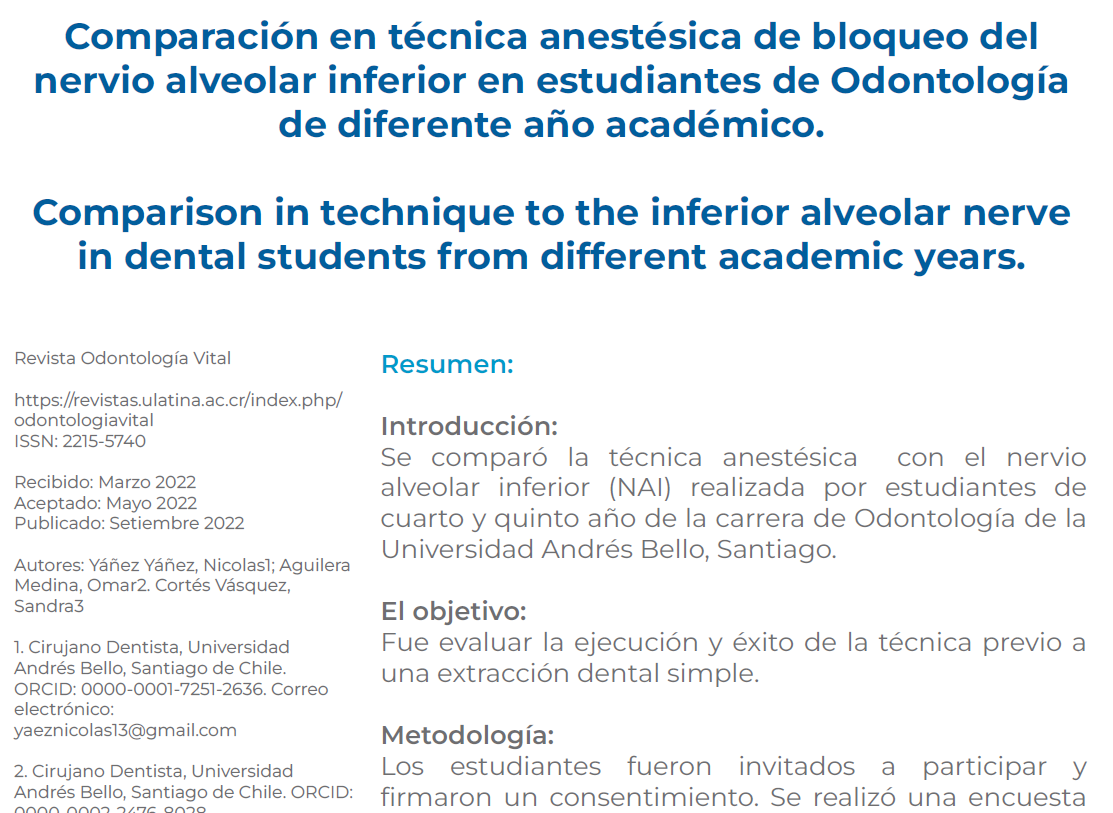Comparison in technique to the inferior alveolar nerve in dental students from different academic years
DOI:
https://doi.org/10.59334/ROV.v1i37.489Abstract
The anesthetic technique to the inferior alveolar nerve (NAI) was compared between the performance by fourth- and fifth-year students of the Dentistry career at the Andrés Bello University, Santiago. The objective was evaluating the performance and success of the technique before a simple dental extraction. The students invited to participate signed an informed consent. A survey was conducted that contained an informative protocol for the student with the steps to follow, then, at the end of their clinical care, had to answer a series of multiple-choice questions. Through this survey, it was evaluated how many students could achieve a correct inferior alveolar nerve block with only 1 tube of anesthesia and how many required additional anesthesia after having injected the first tube of anesthesia, before starting the surgical procedure. Also, the amount of anesthesia tubes that the students used to perform the extraction in a painless way was quantified and how many required an additional anesthetic reinforcement intraoperatively. Thereby, a comparative analysis between both generations of students was carried out in relation to the use of the anesthetic technique. Of the 104 participants, it was found that 57% of the 4th year students and 65% of the 5th year students achieved a correct anesthetic technique at the NAI with a single tube of anesthesia. There were no significant differences in relation to the academic year completed and the variables studied except for the need for anesthetic reinforcement after a successful anesthetic technique, where 4th year students needed to perform more intraoperative pain control.Downloads
References
Ali, M., Arta, A., & Banishahabadi, A. (2019). Evaluation of Success of Inferior Alveolar Nerve Block Technique Applied by Dental Students at Different Educational Levels. 7(2). Obtenido de https://journals.aiac.org.au/index.php/ABCMED/article/view/5329#:~:text=Results%3A%20there%20was%20no%20significant,between%20male%20and%20female%20students.&text=However%2C%20the%20frequency%20of%20the,%2Dyear%20dental%20students%2C%20respectively.
Aliabadi, E., & Keshavarz, E. (2020). Evaluation of knowledge and experience on the success of inferior alveolar nerve block technique. 33(1), 26-31. Obtenido de https://journals.tums.ac.ir/jdm/browse.php?a_id=5981&sid=1&slc_lang=en
Anguiano, N. (2016). Comparison of different periods of anesthetic effect of lidocaine (1 :1 00,000) on intraoperative pain experienced during dental extractions. Oral, 17(53), 1320-1323. Obtenido de https://www.medigraphic.com/cgi-bin/new/resumenI.cgi?IDARTICULO=72897
Aravena, P. (2013). Éxito anestésico de 1,8ml de Lidocaína 2% en exodoncia de dientes mandibulares. Estudio piloto. Journal of Oral Research, 2(1), 23-27. Obtenido de https://revistaschilenas.uchile.cl/handle/2250/24591
Bhatnagar, N., Mantri, S., Dube, K., & Jaiswal, N. (2020). Pulpal-anesthesia of a mandibular first molar with irreversible pulpitis by inferior alveolar nerve block plus buccal infiltration using articaine or lignocaine. J Conserv Dent, 23(2), 201-205. doi:10.4103/JCD.JCD_410_19
García, A., Guisado, B., & Montalvo, J. (2008). Riesgos y complicaciones de anestesia local en la consulta dental. RCOE, 8(1). Obtenido de https://scielo.isciii.es/scielo.php?script=sci_arttext&pid=S1138-123X2003000100004
Herrera, D., Torres, D., & Gutiérrez, J. (2008). Fracaso de la anestesia local en Odontología. SECIB, 2, 11-23. Obtenido de http://www.sld.cu/galerias/pdf/sitios/cirugiamaxilo/anestesia.pdf
Iqval, A. (2017). Mandibular Local Anesthetic Failures: are we taking the challenge seriously. Pakistan Oral & Dental Journal, 37(4).
Joseph, B., & Kumar, N. (2020). Single-insertion technique for anesthetizing the inferior alveolar nerve, lingual nerve, and long buccal nerve for extraction of mandibular first and second molars: a prospective study. J Korean Assoc Oral Maxillofac Surg, 46(6), 403-408. doi:10.5125/jkaoms.2020.46.6.403
Kim, C., & Kyung-Gyun, H. (2018). Local anesthesia for mandibular third molar extraction. J Dent Anesth Pain Med, 18(5), 287-294. Obtenido de https://jdapm.org/DOIx.php?id=10.17245/jdapm.2018.18.5.287
Leal, P., & Hernández, Y. (2016). Evolución de la Odontología. Oral, 17(55), 1418-1426. Obtenido de https://www.medigraphic.com/pdfs/oral/ora-2016/ora1655g.pdf
Lurcov, R., Pop, L., & Lorga, M. (2021). Impact of COVID-19 Pandemic on Academic Activity and Health Status among Romanian Medical Dentistry Students; A Cross-Sectional Study. Int J Environ Res Public Health, 18(11). doi:10.3390/ijerph18116041
Macouzet, C. (s.f.).
Macouzet, C. (2008). Anestesia Local en Odontología. México: Manual Moderno.
Malamed, S. (2013). Manual de Anestesia Local (Sexta ed.). Elsevier.
Ogle, O., & Mahjoubi, G. (2011). Advances in local anesthesia in dentistry. Dent Clin North Am, 55(3), 481-499. doi:10.1016/j.cden.2011.02.007
Wong, G., Apthorpe, H., Ruiz, K., & Nanayakkara, S. (2019). Student-to-Student Dental Local Anesthetic Preclinical Training: Impact on Students’ Confidence and Anxiety in Clinical Practice. J Dent Educ, 83(1), 56-63. doi:10.21815/JDE.019.007
Yang, H., & Lee, R. (2019). Alternative techniques for failure of conventional inferior alveolar nerve block. J Dent Anesth Pain Med, 125-134. doi:10.17245/jdapm.2019.19.3.125

Published
How to Cite
License
Copyright (c) 2022 Nicolas Yáñez Yáñez, Omar Aguilera Medina, Sandra Cortés Vásquez

This work is licensed under a Creative Commons Attribution 4.0 International License.
Authors who publish with Odontología Vital agree to the following terms:
- Authors retain the copyright and grant Universidad Latina de Costa Rica the right of first publication, with the work simultaneously licensed under a Creative Commons Attribution 4.0 International license (CC BY 4.0) that allows others to share the work with an acknowledgement of the work's authorship and initial publication in this journal.
- Authors are able to enter into separate, additional contractual arrangements for the non-exclusive distribution of the Odontología Vital's published version of the work (e.g., post it to an institutional repository or publish it in a book), with an acknowledgement of its initial publication.
- Authors are permitted and encouraged to post their work online (e.g., in institutional repositories or on their website) prior to and during the submission process, as it can lead to productive exchanges, as well as earlier and greater citation of published work.
Métricas alternativas










